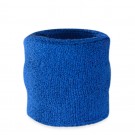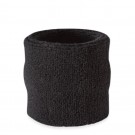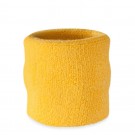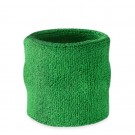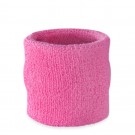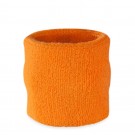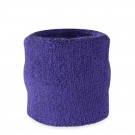Sports wristbands come in a variety of different colors. Click on the color your interested in…
Colored Wristbands for Sports
Sure you’ve seen your favorite stars wearing colored wristbands. Some of them even have their own custom logo on the sweatbands. They look pretty stylish but they are wearing them mainly to stop sweat from ruining their game. Sweat wristbands have been word by sports players for years. Commonly showing up in movies like semi-pro with Will Farrel, they have gotten extremely popular over the years. From top NBA players wearing colored wrist sweatbands to even skateboarders, they do there job perfectly to prevent sweat and add a hint of style.
 The wristband originated in the late 1940’s through the sport of tennis. Legend tennis player, Fred Perry was approached by Austrian football player, Tibby Wegner. Wegener had devised a rather ingenious and brilliant way to reduce perspiration from the wrists. With a few tweaks and modifications Perry then conceptualized the very first wristband. Interestingly Perry did not stop there and he is also the creator of the original tennis shirt. A version of this is still worn today on the tennis courts.
The wristband originated in the late 1940’s through the sport of tennis. Legend tennis player, Fred Perry was approached by Austrian football player, Tibby Wegner. Wegener had devised a rather ingenious and brilliant way to reduce perspiration from the wrists. With a few tweaks and modifications Perry then conceptualized the very first wristband. Interestingly Perry did not stop there and he is also the creator of the original tennis shirt. A version of this is still worn today on the tennis courts.
As for wristbands, they have become synonymous with a number of major athletes and sporting events. These include but are not limited too, basketball, football, tennis and sprinting. To understand the popularity of the wristbands it is crucial to ascertain the function of this piece of wear.
Use Of The Wristband
Wrist sweatbands are used primarily by athletes to stop sweat falling on the eyes and face. A quick, agile wipe and excess sweat can be removed at a rapid speed without delay. Excess perspiring is common in any event that involves excessive amounts of energy or levels of endurance. It is common for individuals to sweat, even when they are not participating in intense forms of physical exercise. This is the key reason why almost everyone uses deodorants for perspiration. However, sports players have more to contend with than just a terrible odor. For sports players, a single bead of sweat could be the difference between winning the final point and losing the match.
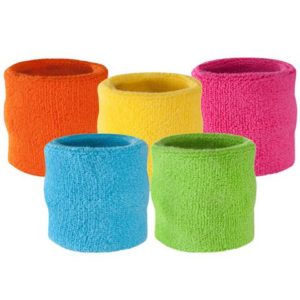
Sweat dripping into the eyes or mouth can be uncomfortable at best. Sweat also causes additional irritation due to burning and itching for people with certain genetic makeups. Many individuals have to deal with skin conditions such as eczema, and for these people, excess sweat could be incredibly painful. It is certainly not something they would want to deal with during an intense and high stake sporting event.
It is interesting to examine how the wristbands are used for different functions in various sports and competitions.
Wristbands In Tennis
In tennis, wristbands are used prominently for wiping away sweat from the brow and mouth. However, they do have another function. During a tennis match, players need to keep a firm grip on their rackets. It would be embarrassing and somewhat shocking if a racket flew out their hand during an intense match. Sweatbands prevent this by catching the excess sweat dripping down the arms that could make the palms slippery and wet. With the perfect hold on the bat, players can get the precision they need for the perfect swing. A winning shot has as much to do with keeping the hands dry as it does with talent playing the game.
Basketball
For basketball, the use of wristbands is quite similar to the function in tennis. Except of course, during a basketball match players need to keep a firm grip on the ball. This is significantly harder than holding a racket due to the shape and make of a basketball. One could easily see how excess sweat might cause a player to lose control of the ball at an inopportune moment.
Sprinting
For sprinting and running, wristbands are primarily used to avoid discomfort and disorientation. Sweat dripping into the eyes can distort the view. It can make running at a rapid pace while maintaining concentration incredibly difficult. Indeed, it is possible that without the proper use of wristbands, a runner might lose their position in a race. Luckily, with a wristband on sprinters can wipe the sweat away, keep running and maintain the pace.
Wrestling And Boxing
Interestingly enough, wristbands are not just used in sports where there are high levels of velocity such as tennis or sprinting. Wristbands are also employed in sports where athletes are confined in a small space throughout a sporting event such as boxing. In boxing, wristbands are used to wipe away sweat and ensure the vision is not blurred. Fantastic vision is vital to ensure that a boxer can get that knockout punch against an opponent.
The original cotton wristbands have been used primarily to reduce the levels of sweat on the body. In particular, on critical areas during a sporting match such as the palm of the hands. However, it is important to realize that the use of sweat wristbands has evolved to include other functions.
Other Uses
Many sports athletes also wear wristbands for another specific purpose. Playing sports often puts intense levels of pressure on different parts of the body, including the wrists. Swinging tennis racket a few times may not result in pain, but after a few hundred swings, the wrists start to burn. Sweatbands alleviate the pain in the wrists less severe, helping players perform at a higher level throughout the match.
American Football
American football games have been noticed wearing wristbands. However, typically they wear them stretched over their biceps rather than their wrists. Many people thought this was for the same primary function of catching sweat before it dripped into the hands. It makes little sense for players to wear the band on their wrists because American football players always wear heavy helmets. However, according to the New York Times, to the reason for wristbands in this sport is far more simplistic. Simply put, players believe they look good accentuating their muscles during a game. This is just one example of how wristbands are used as a fashion accessory as well as their primary function.
Wristbands In Fashion
Sports wristbands have been used as a fashion item in most of the aforementioned sports including tennis. Players often choose wristbands that match the color of their overall outfits or clash in a stylish way. It is also quite common for players to wear wristbands with a unique symbol or designer label. Many major sports designers including Nike, Reebok, and Adidas produce their own sweatbands, worn by top athletes around the world. Designs of the wristbands can also vary in sports from lines of different colors to checkered patterns. These are based on personal preference and have no actual function during a match or game. Many sports athletes have become fashion icons themselves so it is unsurprising that a piece of kit like the sweatband is now part of the trend.
Other Forms Of The Wristband
There are several other forms of wristband that have evolved from the cotton sweatband. In the mid-2000s, silicone wristbands were used to promote charity campaigns such as Make Poverty History. The campaign involved many celebrities including sports players like David Beckham promoting the bands. Silicone bands were chosen for the campaign rather than cotton bands because they were cheaper to produce. While fading in popularity, bands like this are still used for various charitable causes.
Magnetically charged bands are also used by some amateur sports enthusiasts. These are designed to increase blood flow through the body and can, supposedly give wearers extra energy to stay on their feet for longer. The true power of these wristbands is debatable, and they are seen as a derivative of the typical sports band.
Furthermore, wristbands have been used for other types of promotion, extending outside of charitable courses. In the past, athletes have worn wristbands with the symbols of different organizations or charities. These are common at amateur sporting events, compared to professional tournaments.

Most recently, in 2009 handbands entered the world of sports. Primarily used by sprinters handbands serve the same function of the wristband but are worn on the hand. The band slips over the fingers and can be used while running to wipe the face free from sweat. Although these types of bands might be useful for runners, they do pose a significant problem for other athletes. For any sport where a player needs to hold an object or item, the hand band would affect the grip on the object. Tennis players might also find it uncomfortable as it would change the way in which they would need to hold their racket. A solution to this issue might be to wear the handband on the other hand that is not in use. However, some tennis players use two hands to serve. Possibly, for this reason, hand bands have not reached high levels of popularity.
Conclusion
Since the 1940’s, wristbands have been used in a wide aray of different sporting events. Their primary purpose is clearly to rid the body of sweat. As shown, though, their use has now expanded far beyond this purpose. From a fashion accessory to a symbol for charity wristbands now have many functions in the world of sports and society in general.
Although there are now several derivatives of the wristband, as is often the case, the original is still the best. For players who want to keep their vision clear and their bodies free of sweat, the cotton wristband is still the best choice. It will improve performance during an intense game and ensure optimum level of focus. Wristbands are an essential part of a kit for many athletes in a wide range of different sports.
